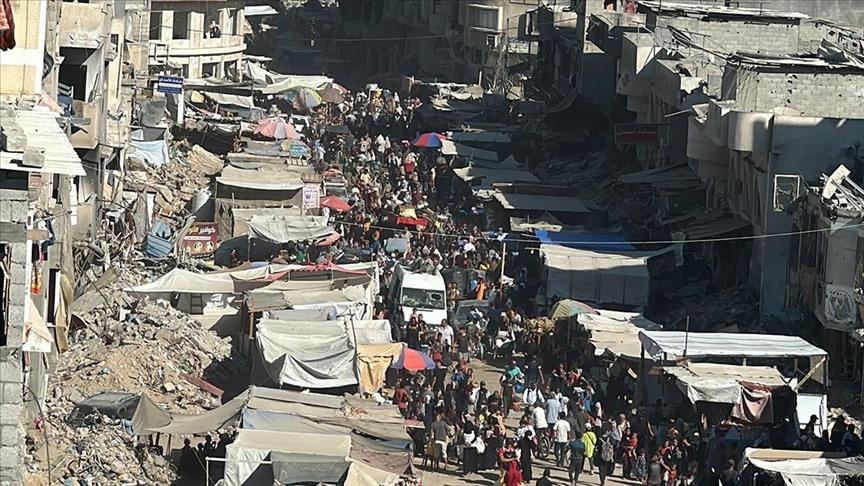9 out of every 10 people in Gaza, where approximately 2.3 million Palestinians live, have been forcibly displaced, according to UN
Mustafa Deveci |10.08.2024

ANKARA
The majority of the population of 2.3 million people in the Gaza Strip has been systematically forced to migrate from their homes by the Israeli army with its evacuation orders since last October 7, and has been driven into a small piece of land.
According to UN data, 9 out of every 10 people in Gaza, where approximately 2.3 million Palestinians live, have been forcibly displaced. Gazans, who are forced to choose between death and forced migration, have been displaced many times.

The people are being forced to migrate due to Israel's attacks that have turned Gaza into ruins.
Due to Israel's ongoing attacks, nearly 39,799 people, including 16,314 children and 10,980 women, have lost their lives in Gaza.

Many Gazans forced to migrate once a month
Forced migration has become the never-ending ordeal of Palestinians in Gaza.
The UN indicates that many Gazans have been forced to migrate once a month since last October. The Israeli army also carries out attacks on areas it claims to be “safe” under various pretenses.
As of Oct. 7, 2023, the Israeli army first concentrated its attacks on the northern region, where more than half of the population of Gaza lives.
In addition to intense airstrikes, the Israeli army, which rained bombs on the region from sea and land, asked the 1.4 million Palestinians in northern Gaza to leave their homes, claiming that the south was “safe.”
Palestinians, who did not want to leave the region despite the attacks, took shelter in hospitals and schools.
However, on Oct. 27, the Israeli army launched a ground offensive in northern Gaza, targeting hospitals and schools in the region, forcing thousands of Palestinians to flee.

Israel also launched ground offensive in Khan Younis
The vast majority of Palestinians forced to flee from the north took refuge in Khan Younis, the second-largest city in Gaza.
On Dec. 1, the Israeli army launched a ground offensive in Khan Younis, where Palestinians fleeing from the north had also taken refuge.
The Israeli army, which declared Khan Younis a conflict zone as in the north, asked the Palestinians there to leave the region.
After this, the Palestinians hit the road again with the few belongings they could take with them.

Israel attacked Rafah, which Biden called a ‘red line’
Palestinians who were displaced due to the attacks intensifying in the north and in Khan Younis migrated to Rafah, where there is little construction on the Egyptian border.
Because there were not enough buildings in Rafah, tens of thousands of Palestinians struggled to survive in makeshift tents.
The population of Rafah, which had a population of about 280,000 before the Israeli attacks, has increased more than 4 times to 1.4 million as displaced Palestinians took refuge in the region.
US President Joe Biden repeatedly said that he opposes Israel launching a ground offensive in Rafah, where displaced Palestinians have taken refuge.
However, Israel launched a ground offensive in Rafah on May 6, which Biden claimed was a “red line.” Despite Rafah being razed to the ground, the US administration turned a blind eye to the attacks, arguing that Israel had not “crossed Biden’s red line” in Rafah.
Some 1.4 million Palestinians who were displaced as a result of these attacks were also forced to flee Rafah in despair.

Israel trying to confine 2.3M Palestinians to tiny piece of land
The Israeli army, which has declared a large part of Gaza a “conflict zone,” is forcing Palestinians to migrate to the al-Mawasi region, which it claims is “safe.”
Israel, which continues to push millions of people into a small piece of land without giving them a chance to breathe, has repeated its threats to gather the population in 12 square kilometers (4.6 square miles).
Al-Mawasi, located on the Mediterranean coast between Deir al-Balah, Khan Younis and Rafah, is a region with no infrastructure and very little construction.
Palestinians who have fled Israel’s attacks are desperately trying to hold on to life in makeshift tents there.
The Palestinian Red Crescent says there is not a single tent left in al-Mawasi due to the migration to the region after the ground attack on Rafah.
According to the UN, only 14% of the Gaza Strip is currently outside the areas Israel wants evacuated.
This means that the majority of the people of Gaza, where approximately 2.3 million Palestinians live, are squeezed into a small area.
Due to the harsh conditions, especially the rising temperature and water shortage, many Palestinians have started living in the rubble of their homes instead of going to al-Mawasi.
Palestinians trapped between Mediterranean, al-Mawasi
In recent weeks, the Israeli army has been demanding the evacuation of some parts of al-Mawasi.
Gazans, who have taken refuge in al-Mawasi, are trapped in a narrow area on the Mediterranean coast.
Israel does not allow Palestinians who are trapped between al-Mawasi and the Mediterranean to return to the areas they came from.
Palestinians who have nowhere else to go are fighting for their lives in al-Mawasi, where they have taken refuge.
There are concerns that the Israeli army will launch a ground attack on al-Mawasi in the future.
*Writing by Gozde Bayar
No comments:
Post a Comment